Evaluating Growth and Nitrogen and Phosphorus Removal of Four Microalgae in Different Nutrient Concentrations
Simple Summary
Abstract
1. Introduction
2. Materials and Methods
2.1. Microalgae and Culture Media
2.2. Culture Methods
2.3. Index Measurement and Analysis
2.3.1. Microalgal Biomass Determination
2.3.2. Nutrient Content
2.3.3. Enzyme Activity
2.3.4. Nitrogen and Phosphorus Removal
2.3.5. Statistical Analysis
3. Results
3.1. Growth of Chlorella sp. Cultured with Different Nutrient Concentrations and Nitrogen and Phosphorus Removal
3.2. Growth of D. zhanjiangensis Cultured with Different Nutrient Concentrations and Nitrogen and Phosphorus Removal
3.3. Growth of N. Closterium Minutissima Cultured with Different Nutrient Concentrations and Nitrogen and Phosphorus Removal
3.4. Growth of P. Subcordiformis Cultured with Different Nutrient Concentrations and Nitrogen and Phosphorus Removal
4. Discussion
4.1. The Growth of Microalgae
4.2. Nitrogen and Phosphorus Removal by Microalgae
4.3. Nutrient Contents of Microalgae
4.4. Enzyme Activities of Microalgae
5. Conclusions
Author Contributions
Funding
Institutional Review Board Statement
Informed Consent Statement
Data Availability Statement
Acknowledgments
Conflicts of Interest
References
- FAO. The State of World Fisheries and Aquaculture 2024—Blue Transformation in Action; FAO: Rome, Italy, 2024. [Google Scholar]
- Dong, S.L.; Dong, Y.W.; Cao, L.; Verreth, J.; Olsen, Y.; Liu, W.J.; Sorgeloos, P. Optimization of aquaculture sustainability through ecological intensification in China. Rev. Aquac. 2022, 14, 1249–1259. [Google Scholar] [CrossRef]
- Liu, L.; Anderson, J.L.; Che, B.; Chu, J.; Garlock, T.M.; Xu, J. An analysis of China’s aquaculture sector for the three pillars of sustainability. Aquac. Econ. Manag. 2025, 29, 231–252. [Google Scholar] [CrossRef]
- Liu, Y.; Lv, J.; Feng, J.; Liu, Q.; Nan, F.; Xie, S. Treatment of real aquaculture wastewater from a fishery utilizing phytoremediation with microalgae. J. Chem. Technol. Biotechnol. 2019, 94, 900–910. [Google Scholar] [CrossRef]
- Yuan, B.; Cui, Y.; An, D.; Jia, Z.; Ding, W.; Yang, L. Marine environmental pollution and offshore aquaculture structure: Evidence from China. Front. Mar. Sci. 2023, 9, 979003. [Google Scholar] [CrossRef]
- Mohsenpour, S.F.; Hennige, S.; Willoughby, N.; Adeloye, A.; Gutierrez, T. Integrating micro-algae into wastewater treatment: A review. Sci. Total Environ. 2021, 752, 142168. [Google Scholar] [CrossRef]
- Phillips, M.L.; McNellis, B.E.; Howell, A.; Lauria, C.M.; Belnap, J.; Reed, S.C. Biocrusts mediate a new mechanism for land degradation under a changing climate. Nat. Clim. Change 2022, 12, 71–76. [Google Scholar] [CrossRef]
- Allzrag, A.M.; Lalung, J.; Hamid, N.K.A.; Rashed, J.A.; Kausar, R.; Kassim, M.A. A Comparative phycoremediation study of aquaculture wastewater treatment by Chlorella sp. immobilized in different hybrid-alginate matrices. Environ. Technol. Innov. 2025, 38, 104158. [Google Scholar] [CrossRef]
- Youcef, S.; Chebbi, M.; Youcef, L.; Bouaziz, M.G.; Soudani, A.; Sahli, A.; Deroues, C. Chemical oxygen demand (COD) reduction in wastewater from the textile industry by coagulation-flocculation and adsorption. Environ. Monit. Assess. 2025, 197, 536. [Google Scholar] [CrossRef] [PubMed]
- Gonçalves, A.L.; Pires, J.C.; Simões, M. A review on the use of microalgal consortia for wastewater treatment. Algal Res. 2017, 24, 403–415. [Google Scholar] [CrossRef]
- Picardo, M.C.; de Medeiros, J.L.; Ofélia de Queiroz, F.A.; Chaloub, R.M. Effects of CO2 enrichment and nutrients supply intermittency on batch cultures of Isochrysis galbana. Bioresour. Technol. 2013, 143, 242–250. [Google Scholar] [CrossRef]
- Giordano, M.; Raven, J.A. Nitrogen and sulfur assimilation in plants and algae. Aquat. Bot. 2014, 118, 45–61. [Google Scholar] [CrossRef]
- Smith, V.H.; Sturm, B.S.M.; Denoyelles, F.J.; Billings, S.A. The ecology of algal biodiesel production. Trends Ecol. Evol. 2010, 25, 301–309. [Google Scholar] [CrossRef] [PubMed]
- Stockenreiter, M.; Graber, A.K.; Haupt, F.; Stibor, H. The effect of species diversity on lipid production by micro-algal communities. J. Appl. Phycol. 2012, 24, 45–54. [Google Scholar] [CrossRef]
- Shurin, J.B.; Abbott, R.L.; Deal, M.S.; Kwan, G.T.; Litchman, E.; McBride, R.C.; Smith, V.H. Industrial-strength ecology: Trade-offs and opportunities in algal biofuel production. Ecol. Lett. 2013, 16, 1393–1404. [Google Scholar] [CrossRef]
- Liang, P.; Wang, H.; Hu, X.; Elshobary, M.; Cui, Y.; Zou, B.; Huo, S. Impact of the NH4+/NO3− ratio on growth of oil-rich filamentous microalgae Tribonema minus in simulated nitrogen-rich wastewater. J. Water Process Eng. 2024, 68, 106378. [Google Scholar] [CrossRef]
- Kumar, A.; Bera, S. Revisiting nitrogen utilization in algae: A review on the process of regulation and assimilation. Bioresour. Technol. Rep. 2020, 12, 100584. [Google Scholar] [CrossRef]
- Xie, T.; Xia, Y.; Zeng, Y.; Li, X.; Zhang, Y. Nitrate concentration-shift cultivation to enhance protein content of heterotrophic microalga Chlorella vulgaris: Over-compensation strategy. Bioresour. Technol. 2017, 233, 247–255. [Google Scholar] [CrossRef]
- Fernandez, E.; Galvan, A. Nitrate assimilation in Chlamydomonas. Eukaryot. Cell 2008, 7, 555–559. [Google Scholar] [CrossRef]
- Morales, M.; Sánchez, L.; Revah, S. The impact of environmental factors on carbon dioxide fixation by microalgae. FEMS Microbiol. Lett. 2018, 365, fnx262. [Google Scholar] [CrossRef]
- Gao, P.; Guo, L.; Gao, M.; Zhao, Y.; Jin, C.; She, Z. Regulation of carbon source metabolism in mixotrophic microalgae cultivation in response to light intensity variation. J. Environ. Manag. 2022, 302, 114095. [Google Scholar] [CrossRef]
- Xu, X.; Gu, X.; Wang, Z.; Shatner, W.; Wang, Z. Progress, challenges and solutions of research on photosynthetic carbon sequestration efficiency of microalgae. Renew. Sustain. Energy Rev. 2019, 110, 65–82. [Google Scholar] [CrossRef]
- Xu, Y.; Wu, Y.; Esquivel-Elizondo, S.; Dolfing, J.; Rittmann, B.E. Using microbial aggregates to entrap aqueous phosphorus. Trends Biotechnol. 2020, 38, 1292–1303. [Google Scholar] [CrossRef] [PubMed]
- Solovchenko, A.E.; Ismagulova, T.T.; Lukyanov, A.A.; Vasilieva, S.G.; Konyukhov, I.V.; Pogosyan, S.I.; Gorelova, O.A. Luxury phosphorus uptake in microalgae. J. Appl. Phycol. 2019, 31, 2755–2770. [Google Scholar] [CrossRef]
- Jansson, M.; Olsson, H.; Pettersson, K. Phosphatases; origin, characteristics and function in lakes. In Phosphorus in Freshwater Ecosystems, Proceedings of a Symposium Held in Uppsala, Sweden, 25–28 September 1985; Springer: Berlin/Heidelberg, Germany, 1985; pp. 157–175. [Google Scholar] [CrossRef]
- Du, R.; Liu, L.; Wang, A.; Wang, Y. Effects of temperature, algae biomass and ambient nutrient on the absorption of dissolved nitrogen and phosphate by Rhodophyte Gracilaria asiatica. Chin. J. Oceanol. Limnol. 2013, 31, 353–365. [Google Scholar] [CrossRef]
- Goldman, J.C. Temperature effects on steady-state growth, phosphorus uptake, and the chemical composition of a marine phytoplankter. Microb. Ecol. 1979, 5, 153–166. [Google Scholar] [CrossRef]
- Bahman, M.; Aghanoori, M.; Jalili, H.; Bozorg, A.; Danaee, S.; Bidhendi, M.E.; Amrane, A. Effect of light intensity and wavelength on nitrogen and phosphate removal from municipal wastewater by microalgae under semi-batch cultivation. Environ. Technol. 2022, 43, 1352–1358. [Google Scholar] [CrossRef]
- da Silva Cerozi, B.; Fitzsimmons, K. The effect of pH on phosphorus availability and speciation in an aquaponics nutrient solution. Bioresour. Technol. 2016, 219, 778–781. [Google Scholar] [CrossRef]
- Li, K.; Jiang, R.; Qiu, J.; Liu, J.; Shao, L.; Zhang, J.; He, P. How to control pollution from tailwater in large scale aquaculture in China: A review. Aquaculture 2024, 590, 741085. [Google Scholar] [CrossRef]
- Villar-Navarro, E.; Levchuk, I.; Rueda-Márquez, J.J.; Manzano, M. Combination of solar disinfection (SODIS) with H2O2 for enhanced disinfection of marine aquaculture effluents. Sol. Energy 2019, 177, 144–154. [Google Scholar] [CrossRef]
- Huang, X.F.; Ye, G.Y.; Yi, N.K.; Lu, L.J.; Zhang, L.; Yang, L.Y.; Liu, J. Effect of plant physiological characteristics on the removal of conventional and emerging pollutants from aquaculture wastewater by constructed wetlands. Ecol. Eng. 2019, 135, 45–53. [Google Scholar] [CrossRef]
- Lananan, F.; Hamid, S.H.A.; Din, W.N.S.; Ali, N.A.; Khatoon, H.; Jusoh, A.; Endut, A. Symbiotic bioremediation of aquaculture wastewater in reducing ammonia and phosphorus utilizing Effective Microorganism (EM-1) and microalgae (Chlorella sp.). Int. Biodeterior. Biodegrad. 2014, 95, 127–134. [Google Scholar] [CrossRef]
- Zheng, J.; Hao, J.M.; Wang, B.; Shui, C. Bioremediation of aquiculture wastewater by microalgae Isochrysis zhanjiangensis and production of the biomass material. Key Eng. Mater. 2011, 460, 491–495. [Google Scholar] [CrossRef]
- Aranda-Vega, Y.; Bhatt, P.; Huang, J.Y.; Brown, P.; Bhasin, A.; Hussain, A.S.; Simsek, H. Biodegradability and bioavailability of dissolved substances in aquaculture effluent: Performance of indigenous bacteria, cyanobacteria, and green microalgae. Environ. Pollut. 2024, 345, 123468. [Google Scholar] [CrossRef]
- Cheng, P.; Huang, J.; Song, X.; Yao, T.; Jiang, J.; Zhou, C.; Ruan, R. Heterotrophic and mixotrophic cultivation of microalgae to simultaneously achieve furfural wastewater treatment and lipid production. Bioresour. Technol. 2022, 349, 126888. [Google Scholar] [CrossRef] [PubMed]
- Ding, W.; Zhou, X.; He, M.; Jin, W.; Chen, Y.; Sun, J. Pollutant removal and resource recovery of co-cultivated microalgae Chlorella sp. and Phaeodactylum tricornutum for marine aquaculture wastewater. J. Water Process Eng. 2024, 67, 106182. [Google Scholar] [CrossRef]
- Seco, A.; Aparicio, S.; Gonzalez-Camejo, J.; Jiménez-Benítez, A.; Mateo, O.; Mora, J.F.; Ferrer, J. Resource recovery from sulphate-rich sewage through an innovative anaerobic-based water resource recovery facility (WRRF). Water Sci. Technol. 2018, 78, 1925–1936. [Google Scholar] [CrossRef]
- Leng, F.; Sun, S.; Jing, Y.; Wang, F.; Wei, Q.; Wang, X.; Zhu, X. A rapid and sensitive method for determination of trace amounts of glucose by anthrone-sulfuric acid method. Bulg. Chem. Commun. 2016, 48, 109–113. [Google Scholar] [CrossRef]
- Su, S.; Zhou, Y.; Qin, J.G.; Yao, W.; Ma, Z. Optimization of the method for chlorophyll extraction in aquatic plants. J. Freshw. Ecol. 2010, 25, 531–538. [Google Scholar] [CrossRef]
- GB/T 12763.4-2007General Administration of Quality Supervision, Inspection and Quarantine & Standardization Administration of the People’s Republic of China. Specifications for Oceanographic Survey—Part 4: Survey of Chemical Parameters in Sea Water; China Standard Publishing House: Beijing, China, 2007.
- De Graaff, M.S.; Temmink, H.; Zeeman, G.; Buisman, C.J.N. Energy and phosphorus recovery from black water. Water Sci. Technol. 2011, 63, 2759–2765. [Google Scholar] [CrossRef]
- Rasdi, N.W.; Qin, J.G. Effect of N:P ratio on growth and chemical composition of Nannochloropsis oculata and Tisochrysis lutea. J. Appl. Phycol. 2015, 27, 2221–2230. [Google Scholar] [CrossRef]
- Magyar, T.; Németh, B.; Tamás, J.; Nagy, P.T. Improvement of N and P ratio for enhanced biomass productivity and sustainable cultivation of Chlorella vulgaris microalgae. Heliyon 2024, 10, e23238. [Google Scholar] [CrossRef]
- Gao, L.; Ding, W.; Xi, J.; Gao, S.; Zhou, X.; Chen, Y.; Jiang, G. Effects of different nitrogen/phosphorus ratios on the growth and metabolism of microalgae Scenedesmus obliquus cultured in the mixed wastewater from primary settling tank and sludge thickener. Process Saf. Environ. Prot. 2023, 170, 824–833. [Google Scholar] [CrossRef]
- Rodolfi, L.; Chini Zittelli, G.; Bassi, N.; Padovani, G.; Biondi, N.; Bonini, G.; Tredici, M.R. Microalgae for oil: Strain selection, induction of lipid synthesis and outdoor mass cultivation in a low-cost photobioreactor. Biotechnol. Bioeng. 2009, 102, 100–112. [Google Scholar] [CrossRef]
- Yuan, X.; Wang, M.; Park, C.; Sahu, A.K.; Ergas, S.J. Microalgae growth using high-strength wastewater followed by anaerobic co-digestion. Water Environ. Res. 2012, 84, 396–404. [Google Scholar] [CrossRef]
- Xin, L.; Hong-Ying, H.; Ke, G.; Ying-Xue, S. Effects of different nitrogen and phosphorus concentrations on the growth, nutrient uptake, and lipid accumulation of a freshwater microalgae Scenedesmus sp. Bioresour. Technol. 2010, 101, 5494–5500. [Google Scholar] [CrossRef]
- Church, J.; Hwang, J.H.; Kim, K.T.; McLean, R.; Oh, Y.K.; Nam, B.; Lee, W.H. Effect of salt type and concentration on the growth and lipid content of Chlorella vulgaris in synthetic saline wastewater for biofuel production. Bioresour. Technol. 2017, 243, 147–153. [Google Scholar] [CrossRef]
- Xie, J.; Zhang, Y.; Li, Y.; Wang, Y. Mixotrophic cultivation of Platymonas subcordiformis. J. Appl. Phycol. 2001, 13, 343–347. [Google Scholar] [CrossRef]
- Mittler, R. Abiotic stress, the field environment and stress combination. Trends Plant Sci. 2006, 11, 15–19. [Google Scholar] [CrossRef]
- Darehshouri, A.; Affenzeller, M.; Lütz-Meindl, U. Cell death upon H2O2 induction in the unicellular green alga Micrasterias. Plant Biol. 2008, 10, 732–745. [Google Scholar] [CrossRef]
- Guo, Z.; Liu, Y.; Guo, H. Microalgae cultivation using an aquaculture wastewater as growth medium for biomass and biofuel production. J. Environ. Sci. 2013, 25 (Suppl. S1), S85–S88. [Google Scholar] [CrossRef]
- Béchet, Q.; Shilton, A.; Guieysse, B. Modeling the effects of light and temperature on algae growth: State of the art and critical assessment for productivity prediction during outdoor cultivation. Biotechnol. Adv. 2013, 31, 1648–1663. [Google Scholar] [CrossRef]
- Kim, J.; Brown, C.M.; Kim, M.K.; Burrows, E.H.; Bach, S.; Lun, D.S.; Falkowski, P.G. Effect of cell cycle arrest on intermediate metabolism in the marine diatom Phaeodactylum tricornutum. Proc. Natl. Acad. Sci. USA 2017, 114, E8007–E8016. [Google Scholar] [CrossRef]
- Markou, G.; Vandamme, D.; Muylaert, K. Microalgal and cyanobacterial cultivation: The supply of nutrients. Water Res. 2014, 65, 186–202. [Google Scholar] [CrossRef]
- Zhang, W.; Ni, Y.; Wang, J.; Zhou, W.; Chen, S.; Li, T.; Li, T. Preliminary study on the absorption of nitrogen and phosphorus by five species of macroalgae. Isr. J. Aquac.-Bamidgeh 2025, 77, 118–125. [Google Scholar] [CrossRef]
- Yaakob, M.A.; Mohamed, R.M.S.R.; Al-Gheethi, A.; Aswathnarayana Gokare, R.; Ambati, R.R. Influence of nitrogen and phosphorus on microalgal growth, biomass, lipid, and fatty acid production: An overview. Cells 2021, 10, 393. [Google Scholar] [CrossRef]
- Zeng, S.; Sun, H.; Liu, Z.; Goldscheider, N.; Frank, S.; Goeppert, N.; Han, C. Changes in the limiting nutrients and dominant phytoplankton communities of three major European rivers: Response to catchment lithologies and human activities. J. Hydrol. 2024, 637, 131362. [Google Scholar] [CrossRef]
- Lin, Y.; He, Z.; Yang, Y.; Stoffella, P.J.; Phlips, E.J.; Powell, C.A. Nitrogen versus phosphorus limitation of phytoplankton growth in Ten Mile Creek, Florida, USA. Hydrobiologia 2008, 605, 247–258. [Google Scholar] [CrossRef]
- Bratt, A.R.; Finlay, J.C.; Welter, J.R.; Vculek, B.A.; Van Allen, R.E. Co-limitation by N and P characterizes phytoplankton communities across nutrient availability and land use. Ecosystems 2020, 23, 1121–1137. [Google Scholar] [CrossRef]
- Domingues, R.B.; Nogueira, P.; Barbosa, A.B. Co-limitation of phytoplankton by N and P in a shallow coastal lagoon (Ria Formosa): Implications for eutrophication evaluation. Estuaries Coasts 2023, 46, 1557–1572. [Google Scholar] [CrossRef]
- Whitton, R.; Ometto, F.; Pidou, M.; Jarvis, P.; Villa, R.; Jefferson, B. Microalgae for municipal wastewater nutrient remediation: Mechanisms, reactors and outlook for tertiary treatment. Environ. Technol. Rev. 2015, 4, 133–148. [Google Scholar] [CrossRef]
- Lin, S.; Litaker, R.W.; Sunda, W.G. Phosphorus physiological ecology and molecular mechanisms in marine phytoplankton. J. Phycol. 2016, 52, 10–36. [Google Scholar] [CrossRef]
- Li, X.; Li, W.; Zhai, J.; Wei, H.; Wang, Q. Effect of ammonium nitrogen on microalgal growth, biochemical composition and photosynthetic performance in mixotrophic cultivation. Bioresour. Technol. 2019, 273, 368–376. [Google Scholar] [CrossRef]
- Berges, J.A.; Mulholland, M.R. Enzymes and nitrogen cycling. In Nitrogen in the Marine Environment; Elsevier: Amsterdam, The Netherlands, 2008; pp. 1385–1444. [Google Scholar] [CrossRef]
- Jia, H.; Yuan, Q. Removal of nitrogen from wastewater using microalgae and microalgae–bacteria consortia. Cogent Environ. Sci. 2016, 2, 1275089. [Google Scholar] [CrossRef]
- Duan, J.; Cui, R.; Huang, Y.; Ai, X.; Hao, Y.; Shi, H.; Xie, Z. Identification and characterization of four microalgae strains with potential application in the treatment of tail-water for shrimp cultivation. Algal Res. 2022, 66, 102790. [Google Scholar] [CrossRef]
- Zhang, F.; Wen, Z.; Wang, S.; Tang, W.; Luo, Y.W.; Kranz, S.A.; Shi, D. Phosphate limitation intensifies negative effects of ocean acidification on globally important nitrogen fixing cyanobacterium. Nat. Commun. 2022, 13, 6730. [Google Scholar] [CrossRef]
- Yu, L.; Gan, J. Reversing impact of phytoplankton phosphorus limitation on coastal hypoxia due to interacting changes in surface production and shoreward bottom oxygen influx. Water Res. 2022, 212, 118094. [Google Scholar] [CrossRef]
- Glibert, P.M.; Wilkerson, F.P.; Dugdale, R.C.; Raven, J.A.; Dupont, C.L.; Leavitt, P.R.; Kana, T.M. Pluses and minuses of ammonium and nitrate uptake and assimilation by phytoplankton and implications for productivity and community composition, with emphasis on nitrogen-enriched conditions. Limnol. Oceanogr. 2016, 61, 165–197. [Google Scholar] [CrossRef]
- Solovchenko, A.; Solovchenko, O.; Khozin-Goldberg, I.; Didi-Cohen, S.; Pal, D.; Cohen, Z.; Boussiba, S. Probing the effects of high-light stress on pigment and lipid metabolism in nitrogen-starving microalgae by measuring chlorophyll fluorescence transients: Studies with a Δ5 desaturase mutant of Parietochloris incisa (Chlorophyta, Trebouxiophyceae). Algal Res. 2013, 2, 175–182. [Google Scholar] [CrossRef]
- Fan, J.; Cui, Y.; Wan, M.; Wang, W.; Li, Y. Lipid accumulation and biosynthesis genes response of the oleaginous Chlorella pyrenoidosa under three nutrition stressors. Biotechnol. Biofuels 2014, 7, 17. [Google Scholar] [CrossRef]
- Liang, Z.; Soranno, P.A.; Wagner, T. The role of phosphorus and nitrogen on chlorophyll a: Evidence from hundreds of lakes. Water Res. 2020, 185, 116236. [Google Scholar] [CrossRef]
- Zarrinmehr, M.J.; Farhadian, O.; Heyrati, F.P.; Keramat, J.; Koutra, E.; Kornaros, M.; Daneshvar, E. Effect of nitrogen concentration on the growth rate and biochemical composition of the microalga, Isochrysis galbana. Egypt. J. Aquat. Res. 2020, 46, 153–158. [Google Scholar] [CrossRef]
- Da Silva Ferreira, V.; Sant’Anna, C. Impact of culture conditions on the chlorophyll content of microalgae for biotechnological applications. World J. Microbiol. Biotechnol. 2017, 33, 20. [Google Scholar] [CrossRef]
- Tossavainen, M.; Ilyass, U.; Ollilainen, V.; Valkonen, K.; Ojala, A.; Romantschuk, M. Influence of long term nitrogen limitation on lipid, protein and pigment production of Euglena gracilis in photoheterotrophic cultures. PeerJ 2019, 7, e6624. [Google Scholar] [CrossRef]
- Fan, J.; Yan, C.; Andre, C.; Shanklin, J.; Schwender, J.; Xu, C. Oil accumulation is controlled by carbon precursor supply for fatty acid synthesis in Chlamydomonas reinhardtii. Plant Cell Physiol. 2012, 53, 1380–1390. [Google Scholar] [CrossRef]
- Jin, X.; Gong, S.; Yang, B.; Wu, J.; Li, T.; Wu, H.; Xiang, W. Transcriptomic analysis for phosphorus limitation-induced β-glucans accumulation in Chlorella sorokiniana SCSIO 46784 during the early phase of growth. Algal Res. 2021, 54, 102208. [Google Scholar] [CrossRef]
- Lagus, A.; Suomela, J.; Weithoff, G.; Heikkilä, K.; Helminen, H.; Sipura, J. Species-specific differences in phytoplankton responses to N and P enrichments and the N: P ratio in the Archipelago Sea, northern Baltic Sea. J. Plankton Res. 2004, 26, 779–798. [Google Scholar] [CrossRef]
- Flynn, K.J. How critical is the critical N: P ratio? J. Phycol. 2002, 38, 961–970. [Google Scholar] [CrossRef]
- Gonzalez-Camejo, J.; Montero, P.; Aparicio, S.; Ruano, M.V.; Borrás, L.; Seco, A.; Barat, R. Nitrite inhibition of microalgae induced by the competition between microalgae and nitrifying bacteria. Water Res. 2020, 172, 115499. [Google Scholar] [CrossRef]
- Amaro, H.M.; Salgado, E.M.; Nunes, O.C.; Pires, J.C.; Esteves, A.F. Microalgae systems-environmental agents for wastewater treatment and further potential biomass valorisation. J. Environ. Manag. 2023, 337, 117678. [Google Scholar] [CrossRef]
- Li, M.; Chen, Z.; Li, X. Physiological and genetic responses of Chlorella sp. to nitrite accumulation in microalgal-bacterial consortium with partial nitrification treating municipal wastewater. Water Res. 2025, 280, 123473. [Google Scholar] [CrossRef] [PubMed]
- Krapp, A. Plant nitrogen assimilation and its regulation: A complex puzzle with missing piece. Curr. Opin. Plant Biol. 2015, 25, 115–122. [Google Scholar] [CrossRef]
- Balotf, S.; Kavoosi, G.; Kholdebarin, B. Nitrate reductase, nitrite reductase, glutamine synthetase, and glutamate synthase expression and activity in response to different nitrogen sources in nitrogen-starved wheat seedlings. Biotechnol. Appl. Biochem. 2016, 63, 220–229. [Google Scholar] [CrossRef]
- Badger, M.R.; Kaplan, A.; Berry, J.A. Internal inorganic carbon pool of Chlamydomonas reinhardtii: Evidence for a carbon dioxide-concentrating mechanism. Plant Physiol. 1980, 66, 407–413. [Google Scholar] [CrossRef]
- Cañavate, J.P.; Armada, I.; Hachero-Cruzado, I. Aspects of phosphorus physiology associated with phosphate-induced polar lipid remodelling in marine microalgae. J. Plant Physiol. 2017, 214, 28–38. [Google Scholar] [CrossRef]
- Kruskopf, M.M.; Du Plessis, S. Induction of both acid and alkaline phosphatase activity in two green-algae (Chlorophyceae) in low N and P concentrations. Hydrobiologia 2004, 513, 59–70. [Google Scholar] [CrossRef]
- Xu, Y.; Wahlund, T.M.; Feng, L.; Shaked, Y.; Morel, F.M. A novel alkaline phosphatase in the coccolithophore Emiliania huxleyi (Prymnesiophyceae) and its regulation by phosphorus. J. Phycol. 2006, 42, 835–844. [Google Scholar] [CrossRef]
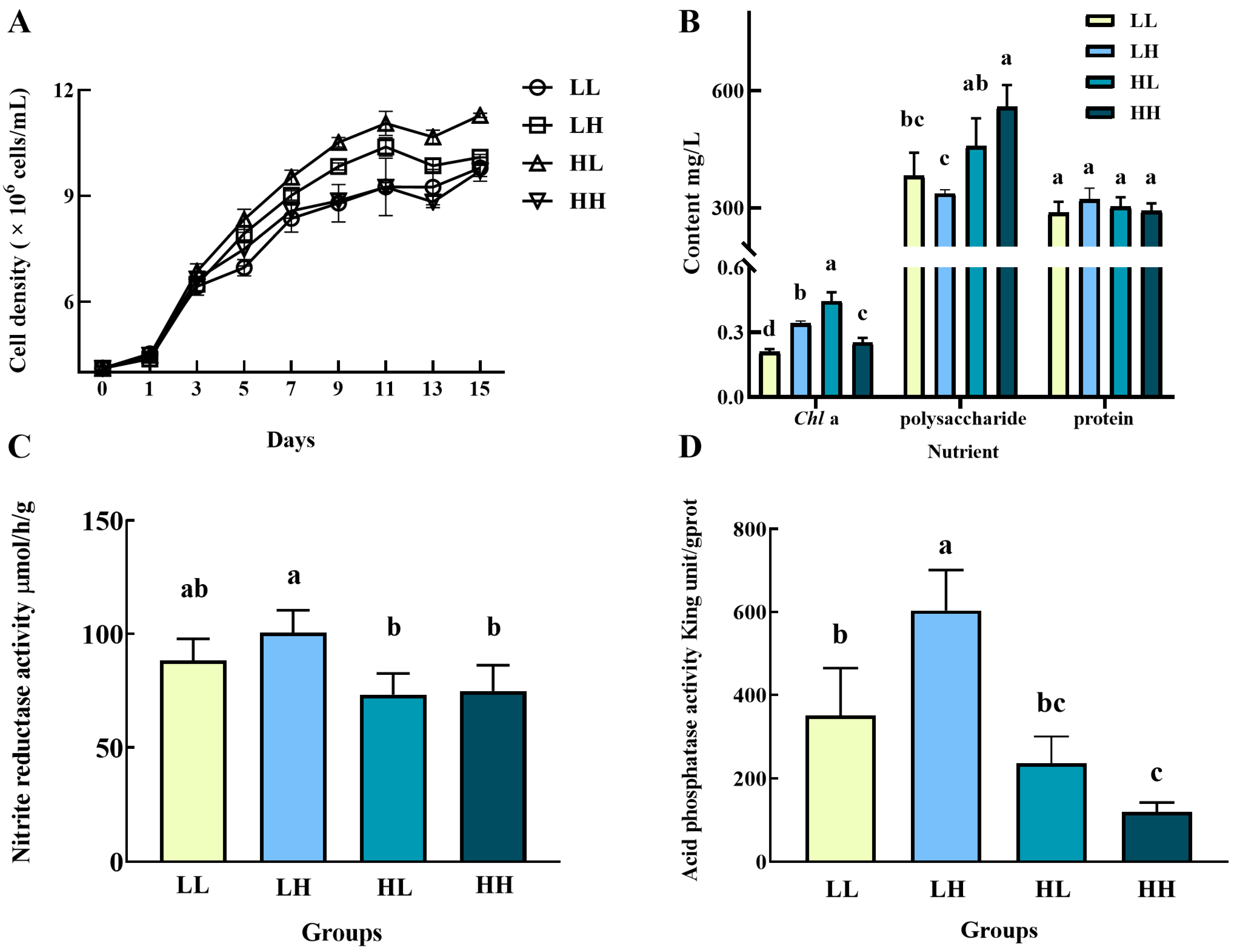
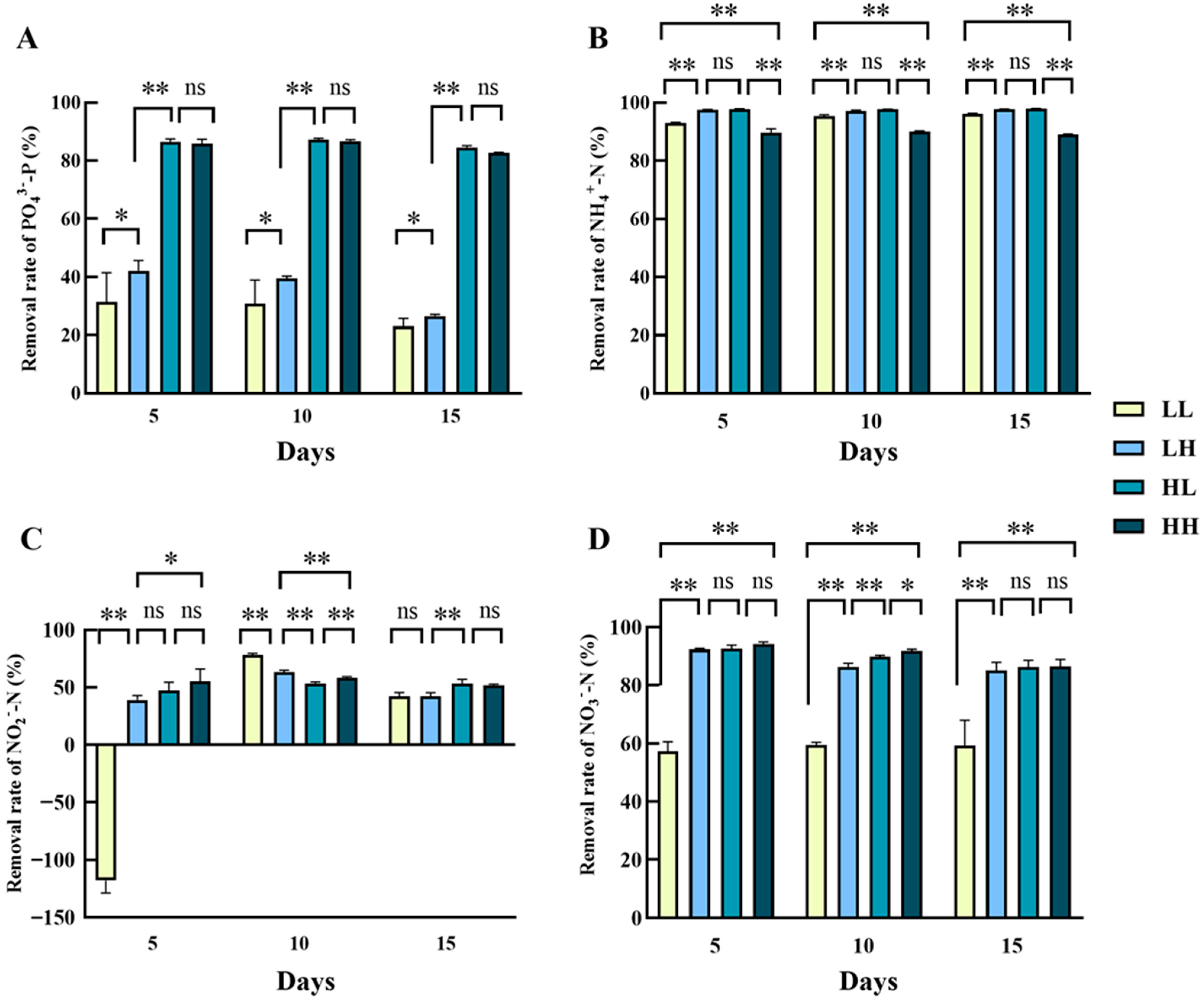
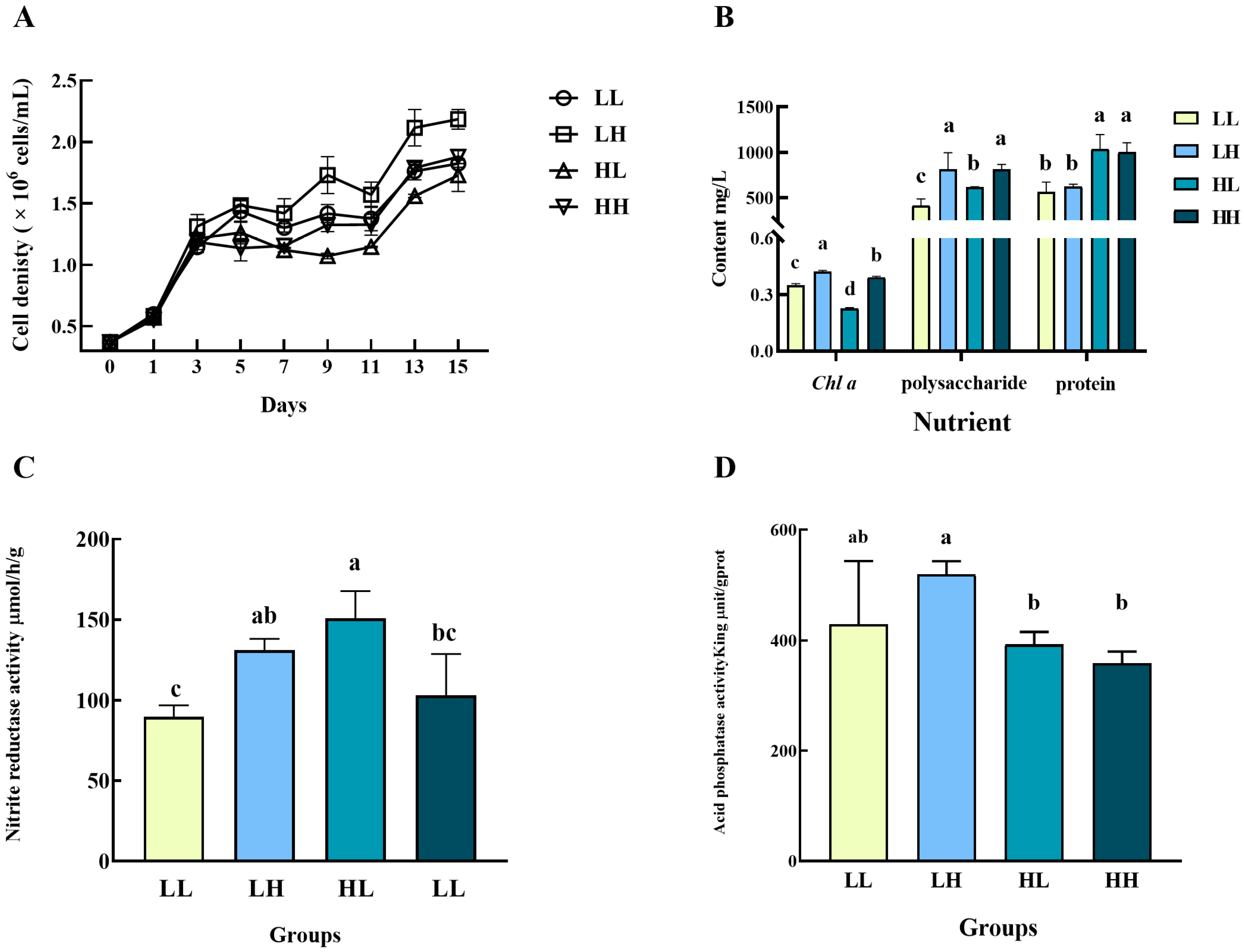
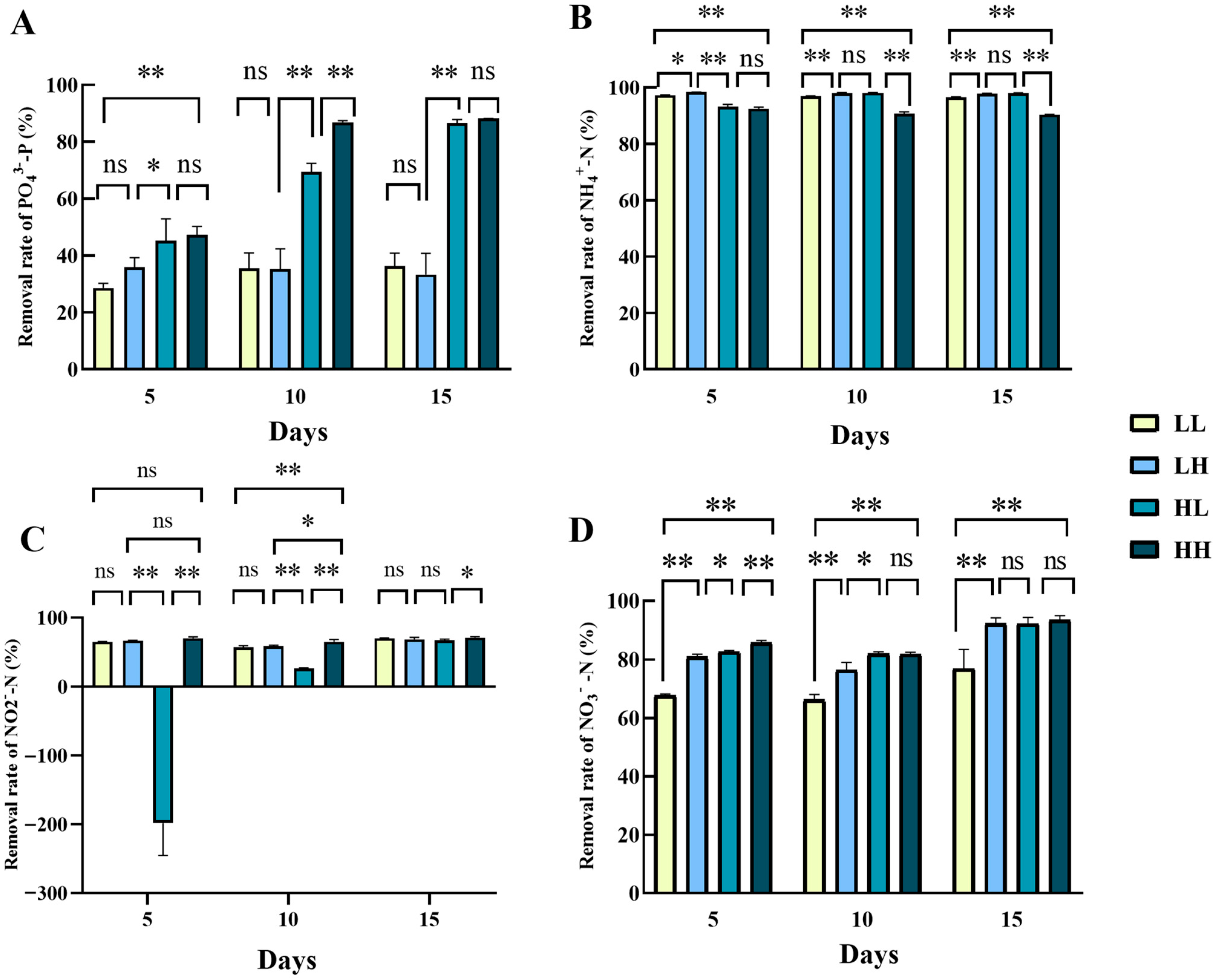
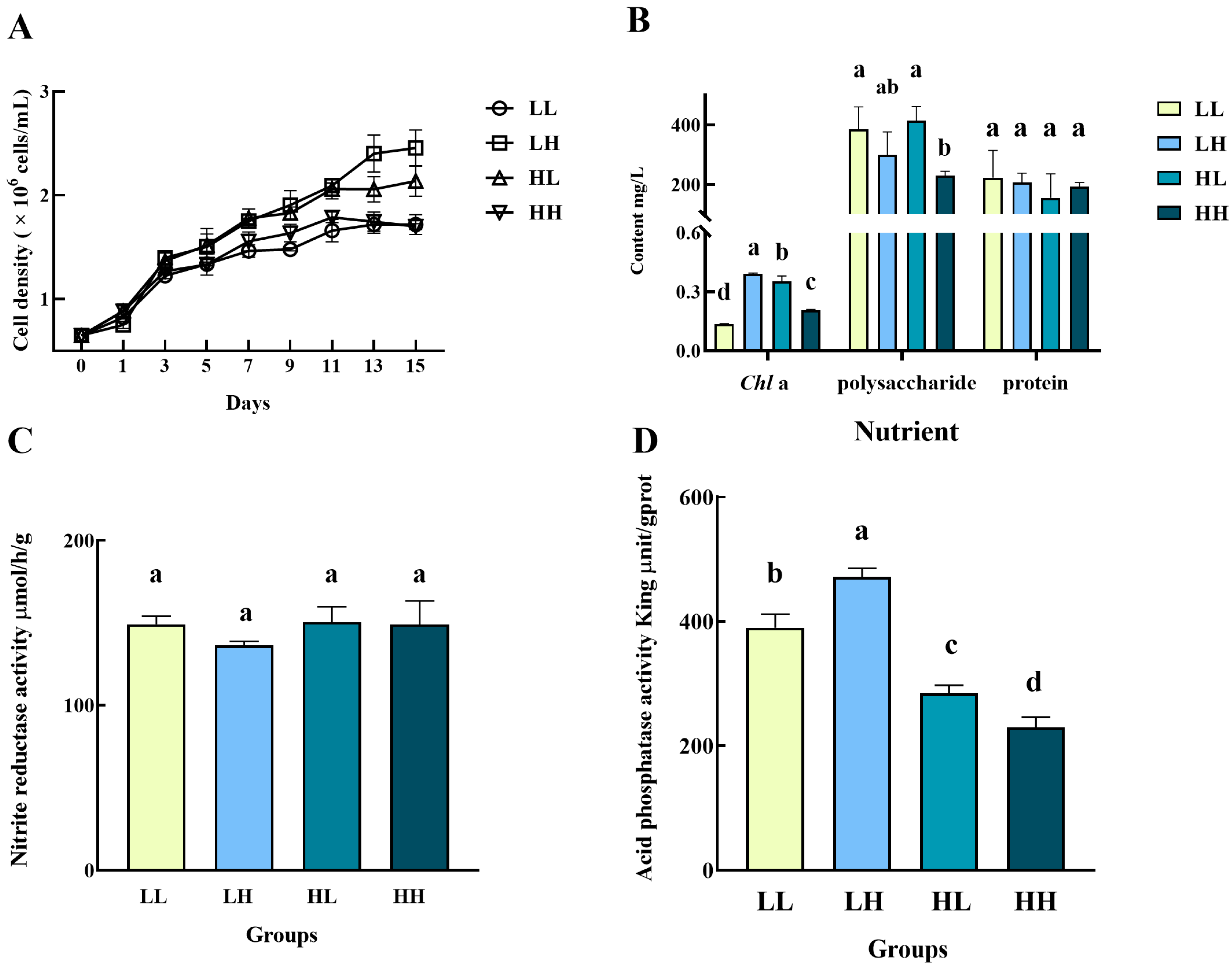
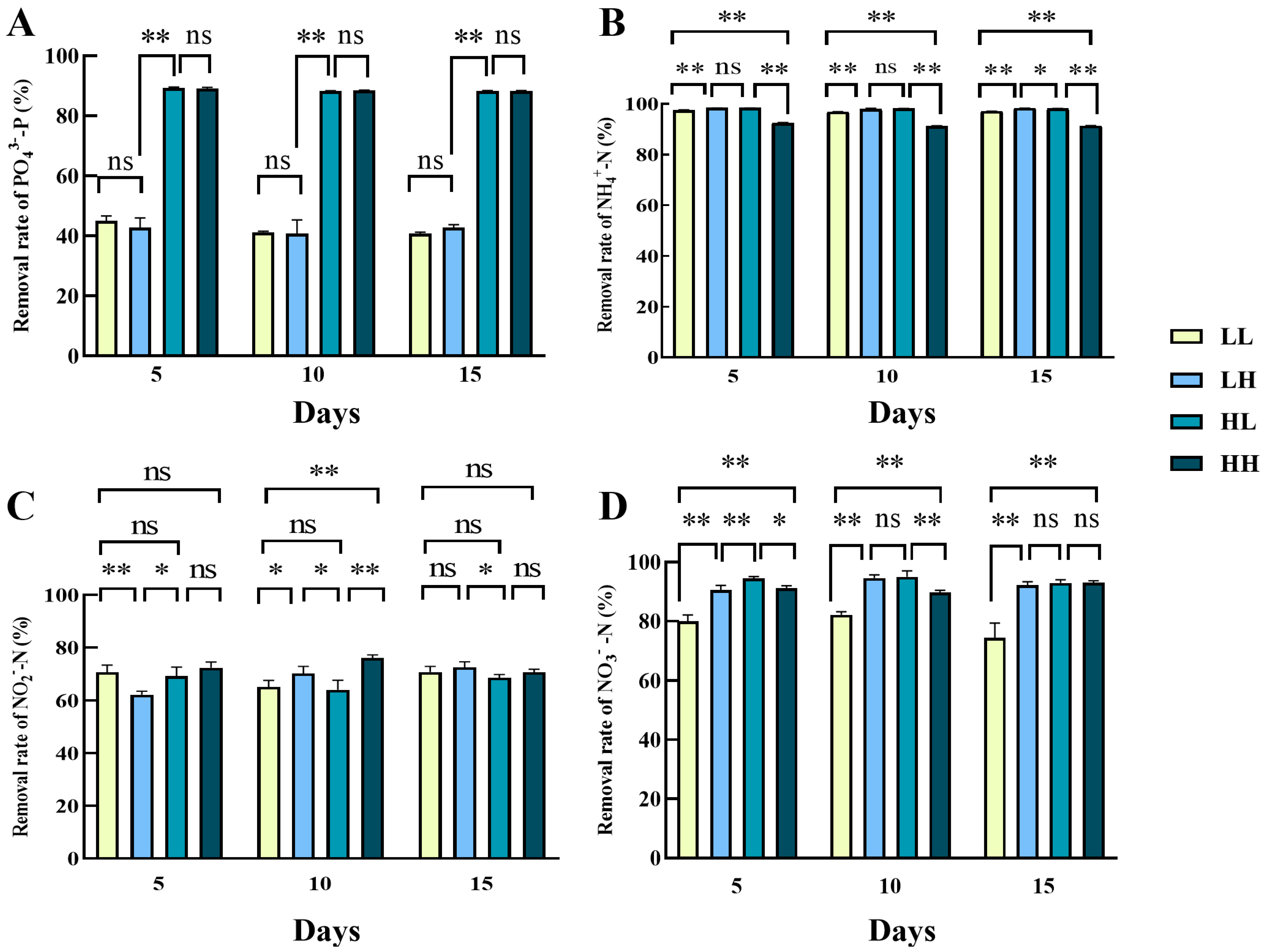

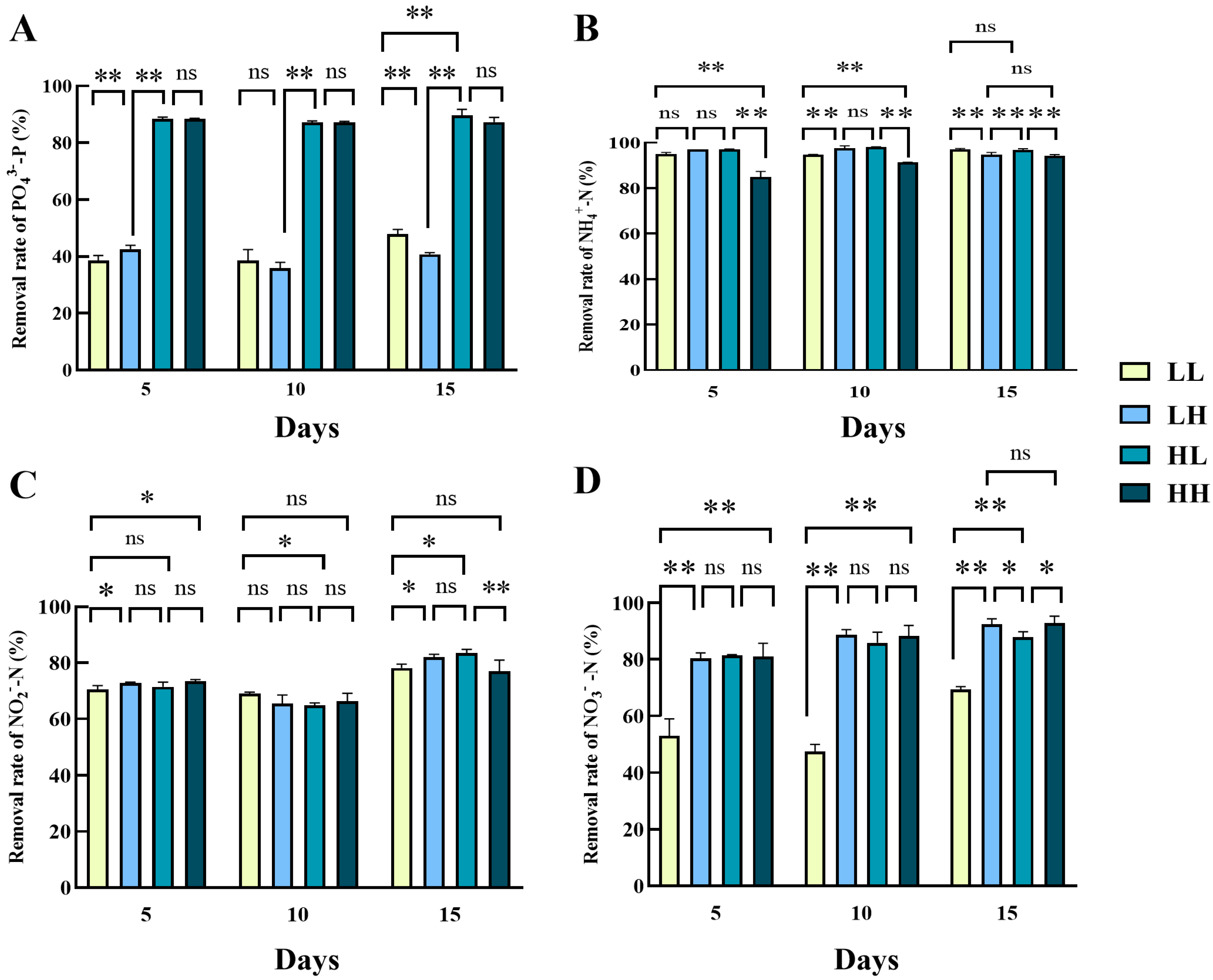
| NH4+ Concentration | PO43− Concentration | |
|---|---|---|
| Low (0.8 mg/L) | High (4.0 mg/L) | |
| Low (0.8 mg/L) | LL | HL |
| High (4.0 mg/L) | LH | HH |
| Characteristics of Aquaculture Wastewater | Simulated Nutrient Concentrations | Microalgae Activities After 15 Day Cultivation | |||||||
|---|---|---|---|---|---|---|---|---|---|
| Density Increase (Times Larger) | Pollutant Removal Efficiency (%) | ||||||||
| Chlorella sp. | D. zhanjiangensis | N. closterium minutissima | P. subcordiformis | Chlorella sp. | D. zhanjiangensis | N. closterium minutissima | P. subcordiformis | ||
| PO43− deficient and NH4+ deficient | PO43−: 0.8 mg/L NH4+: 0.8 mg/L | 1.38 | 3.93 | 1.64 | 0.87 | PO43−: 23.04 NH4+: 96.13 NO3−: 59.27 NO2−: 42.15 | PO43−: 36.31 NH4+: 96.64 NO3−: 76.83 NO2−: 70.53 | PO43−: 40.67 NH4+: 97.07 NO3−: 74.36 NO2−: 70.85 | PO43−: 47.95 NH4+: 96.97 NO3−: 69.39 NO2−: 78.16 |
| PO43− deficient and NH4+ sufficient | PO43−: 0.8 mg/L NH4+: 4.0 mg/L | 1.45 | 4.90 | 2.78 | 2.42 | PO43−: 26.58 NH4+: 97.66 NO3−: 85.09 NO2−: 42.34 | PO43−: 33.40 NH4+: 97.90 NO3−: 92.22 NO2−: 68.89 | PO43−: 42.71 NH4+: 98.28 NO3−: 92.32 NO2−: 72.65 | PO43−: 40.80 NH4+: 94.70 NO3−: 92.34 NO2−: 81.96 |
| PO43− sufficient and NH4+ deficient | PO43−: 4.0 mg/L NH4+: 0.8 mg/L | 1.74 | 3.68 | 2.29 | 2.13 | PO43−: 84.5 NH4+: 97.86 NO3−: 86.27 NO2−: 53.16 | PO43−: 86.50 NH4+: 98.00 NO3−: 92.15 NO2−: 67.59 | PO43−: 88.20 NH4+: 98.10 NO3−: 92.93 NO2−: 68.69 | PO43−: 89.73 NH4+: 96.78 NO3−: 87.87 NO2−: 83.56 |
| PO43− sufficient and NH4+ sufficient | PO43−: 4.0 mg/L NH4+: 4.0 mg/L | 1.36 | 4.08 | 1.61 | 1.31 | PO43−: 82.64 NH4+: 89.06 NO3−: 86.46 NO2−: 51.90 | PO43−: 88.17 NH4+: 90.41 NO3−: 93.46 NO2−: 71.61 | PO43−: 88.30 NH4+: 91.24 NO3−: 93.05 NO2−: 70.82 | PO43−: 87.25 NH4+: 94.18 NO3−: 92.77 NO2−: 76.97 |
Disclaimer/Publisher’s Note: The statements, opinions and data contained in all publications are solely those of the individual author(s) and contributor(s) and not of MDPI and/or the editor(s). MDPI and/or the editor(s) disclaim responsibility for any injury to people or property resulting from any ideas, methods, instructions or products referred to in the content. |
© 2025 by the authors. Licensee MDPI, Basel, Switzerland. This article is an open access article distributed under the terms and conditions of the Creative Commons Attribution (CC BY) license (https://creativecommons.org/licenses/by/4.0/).
Share and Cite
Ma, P.; Li, X.; Wu, B.; Liu, Z.; Li, Z.; Sun, X.; Zhou, L.; Du, M. Evaluating Growth and Nitrogen and Phosphorus Removal of Four Microalgae in Different Nutrient Concentrations. Biology 2025, 14, 1155. https://doi.org/10.3390/biology14091155
Ma P, Li X, Wu B, Liu Z, Li Z, Sun X, Zhou L, Du M. Evaluating Growth and Nitrogen and Phosphorus Removal of Four Microalgae in Different Nutrient Concentrations. Biology. 2025; 14(9):1155. https://doi.org/10.3390/biology14091155
Chicago/Turabian StyleMa, Peizhen, Xiaoqin Li, Biao Wu, Zhihong Liu, Zhuanzhuan Li, Xiujun Sun, Liqing Zhou, and Meirong Du. 2025. "Evaluating Growth and Nitrogen and Phosphorus Removal of Four Microalgae in Different Nutrient Concentrations" Biology 14, no. 9: 1155. https://doi.org/10.3390/biology14091155
APA StyleMa, P., Li, X., Wu, B., Liu, Z., Li, Z., Sun, X., Zhou, L., & Du, M. (2025). Evaluating Growth and Nitrogen and Phosphorus Removal of Four Microalgae in Different Nutrient Concentrations. Biology, 14(9), 1155. https://doi.org/10.3390/biology14091155







